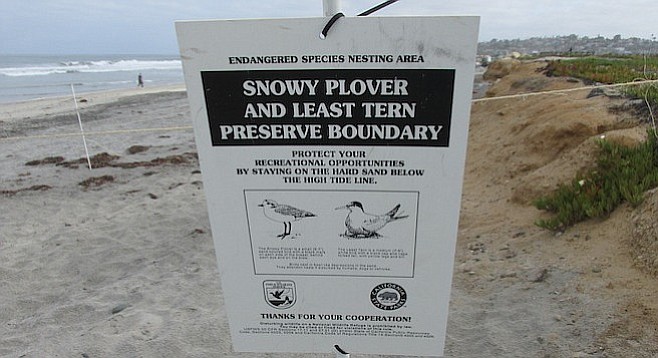 Facebook
Facebook
 X
X
 Instagram
Instagram
 TikTok
TikTok
 Youtube
Youtube

It’s been four months since a small strip of beach in Cardiff by the Sea became federally protected nesting grounds for the western snowy plover. The endangered birds had settled on the beachside of Coast Highway 101, across the road from their protected nesting area in the San Elijo Lagoon Ecological Preserve.
As reported in the Reader, in June state officials found two nests and saw five adults running around at the shoreline and cordoned off that area.
As the birds' mating season comes to an end, the rope barriers and signs will be removed.
“Unfortunately the chicks didn’t make it,” said state parks biologist Darren Smith. Park officials, lifeguards, and the public filed reports on the young birds every few days.
“The chicks went missing about three weeks after they were born. We assume they were eaten by crows,” said Smith. The mating pairs stayed around another month after.
The U.S. Fish and Wildlife Service’s original concern didn’t pan out; that dogs and people on the beach would be the cause the birds' demise. “We had tons of local support,” said Smith. “Beachgoers really rallied around protecting the site.” Now the dialog between the state parks and the feds is: does this site remain protected into next year’s mating season?
“If we're creating habitat for birds that will eventually die, we’re not doing them any favors,” said Smith. Smith’s preference, if the birds don’t return next spring, would be to continue with a project that was started prior to the bird’s arrival — sand-dune restoration. “I think it serves a higher purpose to have the site be interpretive and educational,” said Smit


It’s been four months since a small strip of beach in Cardiff by the Sea became federally protected nesting grounds for the western snowy plover. The endangered birds had settled on the beachside of Coast Highway 101, across the road from their protected nesting area in the San Elijo Lagoon Ecological Preserve.
As reported in the Reader, in June state officials found two nests and saw five adults running around at the shoreline and cordoned off that area.
As the birds' mating season comes to an end, the rope barriers and signs will be removed.
“Unfortunately the chicks didn’t make it,” said state parks biologist Darren Smith. Park officials, lifeguards, and the public filed reports on the young birds every few days.
“The chicks went missing about three weeks after they were born. We assume they were eaten by crows,” said Smith. The mating pairs stayed around another month after.
The U.S. Fish and Wildlife Service’s original concern didn’t pan out; that dogs and people on the beach would be the cause the birds' demise. “We had tons of local support,” said Smith. “Beachgoers really rallied around protecting the site.” Now the dialog between the state parks and the feds is: does this site remain protected into next year’s mating season?
“If we're creating habitat for birds that will eventually die, we’re not doing them any favors,” said Smith. Smith’s preference, if the birds don’t return next spring, would be to continue with a project that was started prior to the bird’s arrival — sand-dune restoration. “I think it serves a higher purpose to have the site be interpretive and educational,” said Smit
Comments